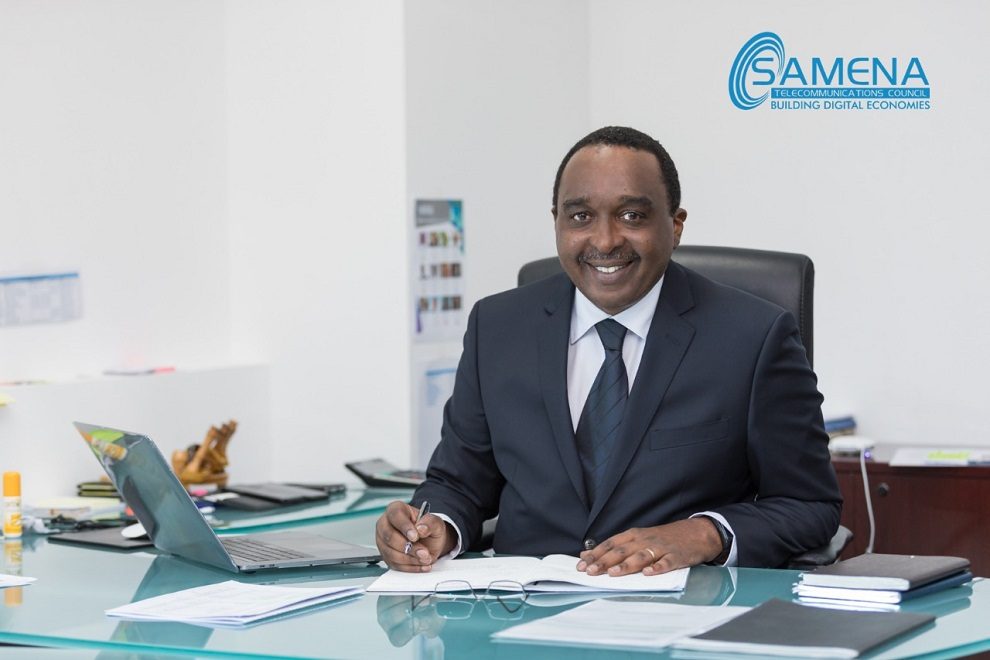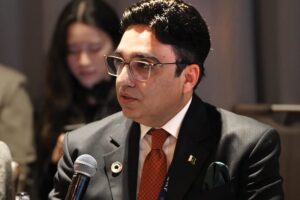Bocar BA
CEO – SAMENA Telecommunications Council
Teletimes: How do you view the post-2020 world, and what are some of the key considerations for the new era?
Bocar BA: More than half of the world is now fully connected online and has begun to participate in the global digital economy. This is a transformative change.
Within the Digital Communications Industry, as well as other sectors–especially Healthcare, Education, and Finance, this change is now actively in play and has set forth a foundation for the enablement of new capabilities as well as possibilities, for not only managing future challenges of pandemic scale, but also for accelerating digital cooperation. To this effect, we are witnessing a greater urgency for the world’s Private and Public sectors to co-operate, to help synergize new collaboration in digital transformation, and to collectively realize greater social and business value-addition.
Nonetheless, there is a tremendous need to formulate effective regulatory approaches in order to achieve more “meaningful connectivity” and “digital inclusion” across the society and the Digital Economy. This requires promoting relevance of digital connectivity and conducting capacity-building of those using the Internet only to a limited scale, or not using at all. Global benefits of digital infrastructure and broadband availability and access have been proven beyond doubt and well-recognized in the wake of the 2020 health crisis. We are truly operating in an era that is both challenging and abundant with new opportunities, and it offers a great chance for businesses and governments to deliver well together at greater scales.
TT: How have the new changes within the industry and the society transformed SAMENA Council’s role?
BB: In addition to being an industry voice for the Private Sector and an advocate for sustainability at large and greater cooperation between Operators and Government bodies, SAMENA Council, despite the challenges the world has faced over the past year, continues to call for and assist in materializing collaboration among stakeholders in the new 5G ecosystem. In many instances, SAMENA Council’s intervention and efforts to fill communication gaps have been instrumental in bringing stakeholders together on unifying platforms–including the Council’s own. SAMENA Council has also had the privilege to carry out strategic messaging to help drive implementation of important recommendations by various global bodies.
SAMENA Council has also been involved in providing Operator-representative feedback to international consultations, to position its Operator Members’ viewpoints and needs in both regional and international discussions and forums, centered on framing new ICT policies to drive innovation and sustainability within the Digital Communications Industry. On an ongoing basis, SAMENA Council is engaged in catalyzing regulatory reforms, encouraging agility, and undertaking collaborative initiatives with likeminded industry bodies and regional governments. The Council looks forward to contributing to leading global initiatives that aim to promote the benefits of mobile communication technologies to help increase digitization and accelerate the attainment of the 17 SDGs.
TT: In your observation, what are some key profitability hurdles for Telecom Operators, and how may these be overcome?
BB: Telecom Operators are operating in complex environs and this, in part, is a major reason why various Policymakers and Regulators have also demonstrated a progressive mindset and temporarily relaxed, for example, spectrum licensing and management rules in view of the sudden and significant increase in data traffic and demand for connectivity.
Overall, however, profitability hurdles are many, with most falling in the categories of Operations, Market Conditions, non-traditional Competition, Regulatory, Spectrum Resources, too many Financial Obligations, challenges in Innovation, and, in some cases, Revenue Degradation. And it is not at all easy to overcome all of these, at once.
Times are calling for revamping cost structures, engaging in smart partnerships, and embracing new technologies such as cloud communications, AI, IoT, Big Data analytics, new mobile applications, and, importantly, enabling sustainable investment in the fifth-generation of mobile technologies. New operating models that make effective use of cross-industry collaboration and help realize cost-savings are becoming among the top business transformation priorities, and Operators are broadening their B2B ICT offerings, taking a leading role in creating a digital ecosystem of solutions across various other sectors, including Education, Healthcare, and Financial Services.
TT: What are Operators doing to make networks more relevant and resilient?
BB: Operators are in the process of enhancing their attractiveness and availability to their customers via new digital services and applications that enrich their trust on Operators and offer a great digital experience. Artificial Intelligence and Machine Learning are being explored and implemented to enable advanced condition-based maintenance capabilities across the networks, for instance. The latter is particularly important for ensuring that the networks are made resilient. In this age of digital transformation, data-based decision-making in real-time by concerned stakeholders is absolutely critical for reducing opex and increasing network asset health, among other requirements.
The Industry acknowledges that Telecom Operators have a crucial role to play in the worldwide efforts toward economic recovery, and that increased network capacity and resilience are a pre-requisite for building a sustainable Digital Economy. Key enabling factors, such as public-private collaboration, improved policy and regulatory enablement steps, aligned well with digital transformation goals set by Operators, and sustainable influx in investment in both infrastructure and incubation of innovation and ICT talent, will play a central role in the Industry’s endeavors to put the economy back on track.
TT: How has Cybersecurity become such an important area of industry collaboration, lately?
BB: Ultimately, all data usage trends and data protection measures to make data access and use efficient and meaningful, will have a direct impact on our collective ability to make progress on the UN’s Connect 2030 Agenda, to fulfill the expectations long-ago defined through the Sustainable Development Goals (SDGs). These are matters of importance to companies, governments, and institutions alike. Through state-level incentivization of data protection and Cybersecurity implementation, many co-related issues can be addressed, such as ensuring online safety of young citizens and children, and proliferation of digital services in the financial, education, and medical sectors, and sustainability issues for the enterprise sector.
If taken coherently, Cybersecurity measures have the power to sustain positivity and hope, and both curtail and fight false information that feeds negativity and hopelessness. With our ripening 5G capabilities and technologies, we now have sufficient means and tools available to us but we need to work toward speedily implementing (and not just discussing) identifiable and practicable Cybersecurity measures.
TT: Given SAMENA Council’s collaboration and presence in multiple global thought-leadership circles, and your own involvement on multiple industry-leadership fronts, what do you consider to be one major challenge in advancing the world’s connectivity drive to ensure digital inclusion for all citizens of the world?
BB: There are well-pronounced gaps that need to be filled when it comes to providing connectivity at affordable prices and at reasonable internet speeds. Undeniably, gaps in funding and financing communication infrastructure development need to be filled, first. Traditional business models for providing telecoms services no longer apply as they once did, and this is one of the reasons why connecting the next billion will be substantially more difficult than it was earlier on when the telecom/ICT landscape was comparatively simpler. Historically, service provisioning has also been driven by revenue and quick return-on-investment approaches, due to which it has not been practical and financially viable for Operators to reach into far-flung areas. Even where USF models have been implemented to bring connectivity to hard-to-reach areas, these have not been issue-free, both in terms of transparency and efficient utilization. Governments, by themselves, lack revenues, models, expertise or even structures to substantially fund development of networks that are required to connect everyone. Even international financial bodies known for funding development projects are also unable to fund every major ICT project across every needy areas. Consequently, insufficiency of digital communication infrastructure funding has come to clear surface.
In short, my opinion is that lack of new funding mechanisms that are attentive to each stakeholder group in our complex digital environment are a major challenge in advancing digital inclusion and achieving universal digital access. But, at the same time, I am also pleased to inform you that we are in the process of developing consensus-driven recommendations to rectify this challenge at a global level.
TT: The Leaders’ Summit 2020 was considered to be among the world’s very first successfully conducted virtual events in 2020, with very powerful messages communicated by Leaders to the Summit’s audience. What are SAMENA Council’s plans for holding the Leaders’ Summit this year?
BB: The complexities of the 5G ecosystem necessitate cross-industry collaboration and it is crucial that we exploit advanced technologies such as AI, cloud and big data analytics, in order to overcome challenges to revitalize socio-economic development and catalyze new investments both within the ICT industries as well as in those sectors that are leveraging advanced mobile broadband technologies and ICTs, in general.
In Leaders’ Summit 2021, which follows the theme “Championing Digital Economic Growth from Policy to Reality”, we will take the discussion forward from Leaders’ Summit 2020.
Leaders’ Summit 2021 will welcome Chairmen and CEOs from the private sector, and top decision-makers from various regulatory authorities, spanning multiple geographies. It will also include participation of global leaders and entities focused on institutionalizing and fostering cross-sector collaboration, making the Leaders’ Summit 2021 the year’s premier virtual destination for leadership, dialogue, demonstration, and for defining future policy actions, as the world embraces new norms in socialization and business conduct. To this effect, the Summit may help support new socio-economic growth through dialogue on policy adaptation and prompt business-enabling regulatory measures that reduce gaps between investment and business profits.
This year, anticipating the process of various Policymakers, including globally-renowned personalities, we have two main objectives: One, to contribute toward propelling digital-led economic growth to put life back on track after the pandemic, by identifying growth opportunities for businesses across industries/sectors, in-line with actual B2C & B2B technology requirements, and, two, driven by policy adaptation and prompt business-enabling regulatory measures, sharing insights on how the gap between investment in new technological innovations to support socio-economic growth and business profits can be reduced.
Teletimes is a Media Partner to SAMENA Council and, with pleasure, we look forward to its presence in Leaders’ Summit this year as well.












